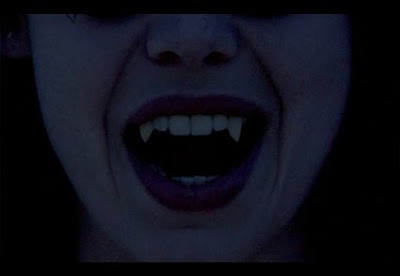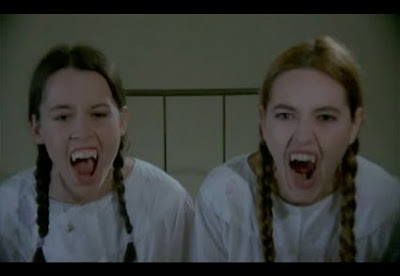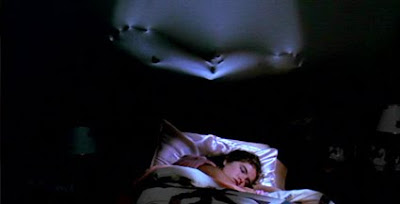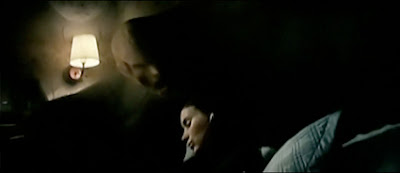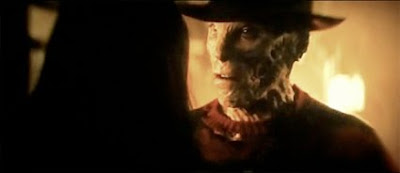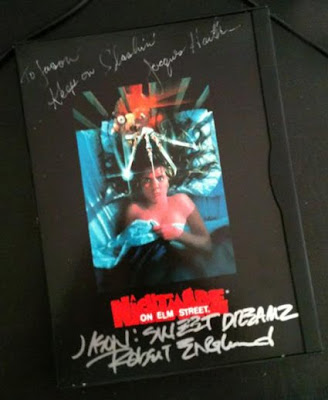

Henry: Portrait of a Serial Killer
Directed by: John McNaughton
USA, 1986
Drama/Horror, 83min
I was checking out the premiere entry over at Jenny Spencer’s The Bloody Iris, and at the end of her entertaining piece on Bill Lustig’s classic Maniac 1980, Jenny recommends a bunch of other stuff. One title on her list is John McNaughton's Henry: Portrait of a Serial Killer. And that alone made me go back and re-watch Henry, as I’ve been longing to get back to that one for a shit long time now… and it was well worth it.

Ok, so here’s a headfuck for your Sunday leisure – How John McNaughton registered death without taking sides.
Henry: Portrait of a Serial Killer has been an important movie for me quite some time. It was during my film studies in the early nineties - when Laserdisc’s still where the preferred choice of cineastes - that I was grated some money by my tutors to purchase some titles within the horror field for the school library as they had none. As I was paying for the selection of second-hand discs I’d picked out, the guy who ran the shop, recognizing that I was into horror, asked if I had heard of Henry: Portrait of a Serial Killer? Well of course I knew it from the genre mags, but I still hadn’t seen it, so when he presented me with the disc fresh from the latest titles I had to pick it up. Back at the university, my tutor and I sat down to a double feature and discussion about Night of the Living Dead and Henry. After NoTLD we compared notes and talked at ease about the symbolism, metaphors and narrative. We carefully placed the next bigass disc on the tray and hit the play button.
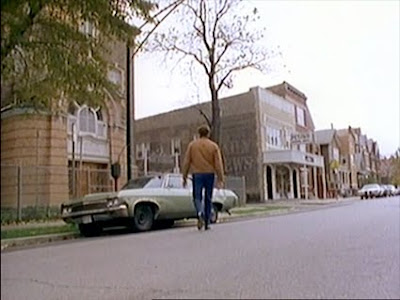
But following those last lines “Yeah I killed my momma” I looked down at the sparse notes I had taken down and turned to my tutor for further discussion. He sat there with his hand to his mouth as to hold back his gagging, managing to blurt out that this was the most disturbing and vile movie he had ever seen. He also pointed out that he have no choice but to fail my paper if I chose to write about this movie, as he found that there was nothing positive to say about the movie what so ever. It was merely a showcased of depravity. I subjected an essay on the movie, and he obviously rejected it forcing me to write a second one on another movie instead. When I finished my studies some years later, I even took the Laserdisc with me as he still felt I had nothing to do in the library the university had assembled.

Needless to say Henry: Portrait of a Serial Killer became my “you HAVE to see this” movie for some years and here’s a reminder of that horrible movie to refresh your memory – or lure you into seeing it for a first time in case you may have missed it.

Chicago, USA. Serial killer Henry shares an apartment with his jail buddy Otis. Becky, Otis sister, moves into their apartment after walking out on her “difficult” husband. At the age of fourteen Henry was incarcerated after murdering his mother, a disturbed prostitute who forced her son to wear women’s clothing and watch as she had sex with men. Henry persuades Otis to take part in his killing spree, and one night when Henry leaves Otis and Becky alone to go out and buy cigarettes, Otis rapes Becky. Henry walks in on them and in a fury kills Otis. Henry cuts up the body, and together with Becky throws them from a bridge, before checking into a motel. The next morning Henry checks out and leaves a bloody suitcase by the side of the road.

After revisiting the movie, it would be easy to use the description of realism film theoretic Louis Gianetti explains in his book Understanding Movies; "existing sound, central dominance within the frame, open and long takes, and synchronous sound" - all of them forms that John McNaughton has used in his debut feature Henry: Portrait of a Serial Killer.

For this reason it would be easy to place the movie within the realistic film theory category, as Henry: Portrait of a Serial Killer almost comes off as an observing documentary, and for some odd reason the Mayles' brothers Salesman [1968] comes to mind several times as I watched the film. But then something starts to shift in my mind, I recognize the theory of realism as described by Gianetti - but they don’t quite add up in relationship to the language that the film talks, or the techniques used in it. Upon a second viewing the traits of the classical narrative are more obvious, deliberate zooms in and out of scenes as they start and come to an end. Edits are hidden away in sound, audio flashbacks, non diegetic sound and “fade-to-blacks” in-between acts – all characteristics that give the movie away as having a classical narrative.

It’s an easy mistake to make, taking the classical narrative as a piece of realism, which rings true for many of the movies in the “extreme” fringes of the horror genre. One of the few sincere tricks to expose a snuff movie is that there are edits. If you start cutting off someone’s arm, you are not going to be at the same spot after the edit to the close up. Real life atrocities are almost always shot in a wide master shot as there isn’t a though given to dramatizing the terrible events being shot. If you focus on the images and not on the “craft” you will fall for the tricks of the trade. In the case of Henry: Portrait of a Serial Killer I should mention that Allen and Gomrey point out “classical Hollywood narrative is passive” in their book Film History, Theory and Practice. This means that all we need to know is presented in front of us, but this is not the case with Henry, also there is no cause-chain effect that releases the events and wrath of Henry upon his victims. Neither is there a clear protagonist / antagonist pointed out which are common traits of the classical dramaturgy. Sure, in some scenes Henry comes off as “the hero” at certain moments compared to Otis who seems to be “the villain” in the same scenes. Within the classic narrative there is often an obvious hero/heroine to which the audience can identify and bond mentally with. McNaughton takes measures to make sure that we don’t bond with the characters in Henry: Portrait of a Serial Killer, and doesn’t let us identify with any of them. This evokes an almost drama/documentary mood as we are thrown into the lives of these people without any obvious start, nor a typical closure to the movie. Henry is a killer in the beginning and is still a killer at large at the end of the movie. The fraction observation of slice of life affects us in such a way that we experience the movie to be realistic.

After finally establishing that the film has a classic narrative, I still can’t get my head round that feeling that the movie is told with a realistic viewpoint. I’d like to claim that it’s all because of the way McNaughton showed the events happening in the film, from a distance and an objective stance. There are rarely any shots where he forces experience or opinion towards his audience by force feeding us deliberate shots; all he does is subtle zooms towards where we would be paying attention. Everything that we learn in this movie happens in the now, and that previously mentioned end scene proves that McNaughton leaves all conclusions and interpretations to us, the audience. This position, a registering one, is typical for the documentary genre, which adds to the difficulty of categorizing Henry: Portrait of a Serial Killer, as it simultaneously with the registering stance, also has a classic narration. Together they both make up the realistic feeling of the movie, which is a major influence on the way the movie is experienced.
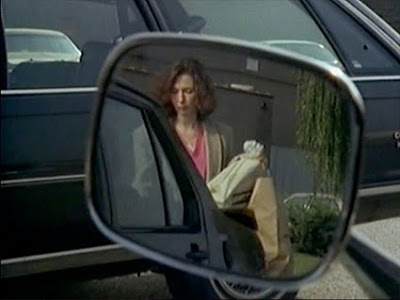
The cold disassociated emotional setting that among others the late Chas Balun commented in I Spit in Your Face: Films That Bite", The DEEP RED Horror Handbook confirms that the movies hold is definitely an emotion awoken by McNaughton’s deliberate distance to the narrative.
As McNaughton takes an objective point of view to the events unfolding on screen, he takes the registering position, as does the audience. This registering position makes the hideous crimes we see less emotional for us, as we don’t step into the victim’s character or suffering. We have no emotional bond to them and neither have we made an investment into their character. It’s quite unsettling when you think about it, because this makes us dismiss the seriousness of Henry’s killing spree easier, as we more or less accept them as his pastime activities. The second thing that builds up that uncomfortable feeling is that somewhere in out subconscious are still getting the signals that what he is doing is wrong. Unconsciously this scares us as we start to fear our own feelings and reactions, startled by our own indifference. The fear is all of a sudden much closer to us, among us. Consequently the registering position of the film contributes to a paradoxical self-examination within the audience. A third device is the way the movie moves forth, which also adds to the alienation. During the first part of the movie we never see the killings. Bodies pile up and Henry [Michael Rooker] keeps his back to the camera, always in motion, always keeping a distance as he keeps ahead of us at all times. Also McNaughton edits away in the midst of camera movement. The camera rarely lands at its steady destination before he cuts to the next image creating unease with the audience. Not to mention the six murders before the Otis [Tom Towles] and Becky [Tracy Arnold] story is presented.

But we are not completely passive against the position McNaughton forces us into as it also induces frustration with the audience. An example of this is the rape of Becky. Here McNaughton chooses to position the camera in the far corner of the room, and show the terrible episode from a wide master shot. We the audience want to act - help her - instead of just observe the action, but the camera won’t allow us to step in closer. We are held so afar that it’s impossible to help Becky, which is why our frustration engages us in her suffering.
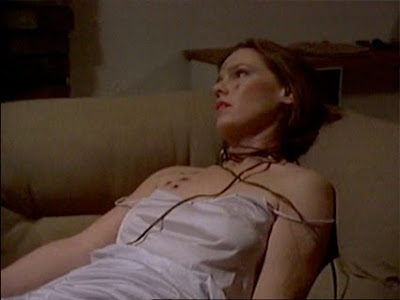
It’s important in this context to note the difference between taking a registering position and not taking a standpoint. McNaughton was accused several times for not taking a standpoint towards the atrocities shown in the film. This critique is in my opinion somewhat naïve and shallow, because not speaking out on one’s standpoint does not mean that you don’t have one. By not speaking out is in its self actually a position. More than often we see serial killer movies that try to explain the events that lead up to the killers state of mind and raison d’être, and it’s always so unsatisfying that it starts to annoy instead of give some sort of sympathetic insight to the killers mind frame. In McNaughton’s case I feel that the choice of not exposing the back-story and just mentioning it briefly adds to the uneasy feeling that you get from the film. McNaughton indicates that a terrible childhood “might” be the reason behind Henry’s killings, but it’s a poor excuse. Again through not commenting on Henry’s reason for being Henry, which a film told with a classic narration would have done, the movie is accepted as realistic. So you shouldn’t confuse a registering position with not having a perspective on what you show.
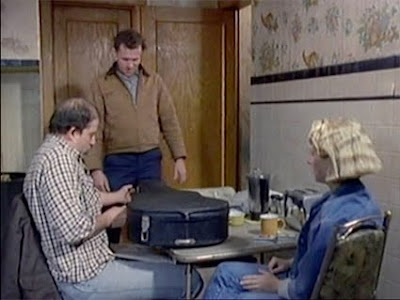
Through the registering position we never make any close bonds with the characters in the story to identify with them. This has us instead of seeing “us” in them, just observe “them”. This enhances the “peeping tom” feeling that often is referred to as Voyeurism. Film Theorists like Metz argue that discourse disguises itself as story with in the classic narrative. This invites a voyeuristic approach to the movie as it becomes an object presented by a sender (McNaughton) who hides rather than confronting us. As we are only registering the events on screen and can’t emotionally interact with the characters, we subconsciously feel like peepers getting insights into things we shouldn’t be seeing. As the characters aren't aware of our presence while they go about their evil deeds, our interest into what they are doing is enhanced. At the same time there is no danger to us as we are hidden voyeurs.
In Henry: Portrait of a Serial Killer we observe the darkest sides of humanity. But we never quite understand that, as we don’t relate to Henry or his victims. Yeah, we do recognise some of Henry’s emotions, but because of the positioning McNaughton has chosen – the objective – we never connect with Henry and his victims, which make the movie even more unnerving, as the unexplainable and non-identifiable scares us more than our personal traits that we easily recognize.

The observing gaze that we take on throughout the film almost makes us look upon the victims in the same way as Henry does. He does not know them, has no feeling for them and therefore sees them as items with no human value. What we instead react to is the graphic violence – the mutilated bodies and blood. As we rarely actually see Henry kill a victim in the movie, we neither get that emotional reaction, that empathy for human suffering.
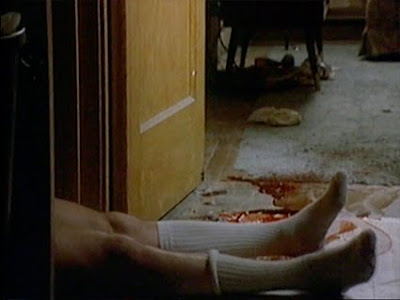
The single time that we feel for one of the characters is in the horrific scene when Becky is raped by Otis, her own brother. To explain WHY we feel emotion first here, I need to backtrack over previous events. Becky is the only character to show any human emotions. She does what she thinks is the right thing, to give Henry the female love he never received from his mother as a child. As Henry tells her about his mothers death you will notice how the camera moves in closer and closer, on Becky and Henry as he opens up for the first time. We understand by the look on Becky’s face that she sympathizes with Henry. This single intimate moment is shattered and the camera quickly withdraws shoving us back into the objective spot, and we realize that off camera Becky has put her hand over Henry’s to show her compassion. Also note that in line with the registering position that McNaughton wants us to hold, he resists the urge to affect us or influence our emotions by laying down a romantic score, or giving the lighting and lenses a softer edge. But back to Becky; from this moment on she takes a more obvious feminine attitude, she wears dresses instead of pants, she changes her makeup, and accepts her womanliness. Not even here does McNaughton waste time to explain this transformation, he doesn’t explain that Becky loves Henry, he sticks to his registering camera position and never enters the characters minds. It’s the audience that are challenged to make the decisions, and what we don’t see on the screen we look for in other conventions, i.e. patterns we recognize from other movies. "...the memory of every film one has enjoyed acts as a model for the next one." as Metz states in his Story/discourse: Notes on two kinds of Voyeurism, (Movies and Methods Vol II 1985, ed Bill Nichols). In our knowledge of classic narrative we know that girl meets boy, feelings are responded to and we end up with a happy ending. So we associate to these conventions and subconsciously start hoping that Becky will have Henry and that’s why we understand, even though the camera is only a registering device, that Becky loves Henry.

This is also the first time we sympathize with a character, we want Becky to get her happy ending and that’s why we feel so strongly for her in the rape sequence, why we want to get in there and rescue her, and why we almost cheer Henry on as he slays Otis. Becky's the first sympathetic character on screen, and as a character playing on the audience’s sympathy she has to pay the ultimate price. She may have been saved for now, but she will not become emotional luggage to Henry, which is what the symbolism and metaphor of the suitcase is in that grim ending of the movie. As if you never understood what’s in there! Our sympathy means nothing in the context of the forced approach the movie is told under. This audience empathy means nothing in the world of Henry, and it has no effect on him either. Hence the darkness.

I just want to clarify that these emotions are not aroused by anything that McNaughton’s positioning does, but rather the opposite. By holding his registering position and not adding value to what we see, the audience is forced into certain situations as the lack of directorial comments make us fill in the blanks with our own associations. If he had used classic narration, I can assure you that there would have been a montage there to lead us by the hand into the emotional state wanted. McNaughton does nothing to manipulate his audience, it's all done by themselves.

The storytelling position of Henry chooses not to give any answers or explanation concerning the events of the plot. McNaughton unleashes Henry without taking a position. He neither condemns nor applauds Henry’s actions. It’s all cold and observing leaving that uneasy gut feeling with the viewers, as it’s us who have been passively watching the events unfold. Perversely feeding our voyeurism, as we aren’t let to engage in the discourse.

The narrative is non-passive and there is no obvious cause-chain-effect as mentioned earlier. This all adds up to making the movie live on longer in the audience, it almost becomes an unsolvable riddle, as you can’t quite let the movie go before figuring out the answers. Henry: Portrait of a Serial Killerleaves the audience with a lot of unanswered questions. It evokes a mental inner space with the viewer where it lives on, feeding off the associations, experience and questions they have. Questions that they usually get the answers to within the classic narrative, which is why Henry: Portrait of a Serial Killer is such a gem of American independent horror cinema. One that without compromise still delivers a hard kick to the gut and shows no traces of aging in the twenty-four years passed since it was made. It’s a dark haunting timeless classic that could be one of the most provocative movies ever made.

Note that no human beings where harmed in the making of this movie, and if you where provoked by the graphic imagery in this piece, then you obviously didn't read the warning before entering the site - which leads me to believe that you where only here to look at the pictures in the first place.























 Two Orphan Vampires
Two Orphan Vampires
